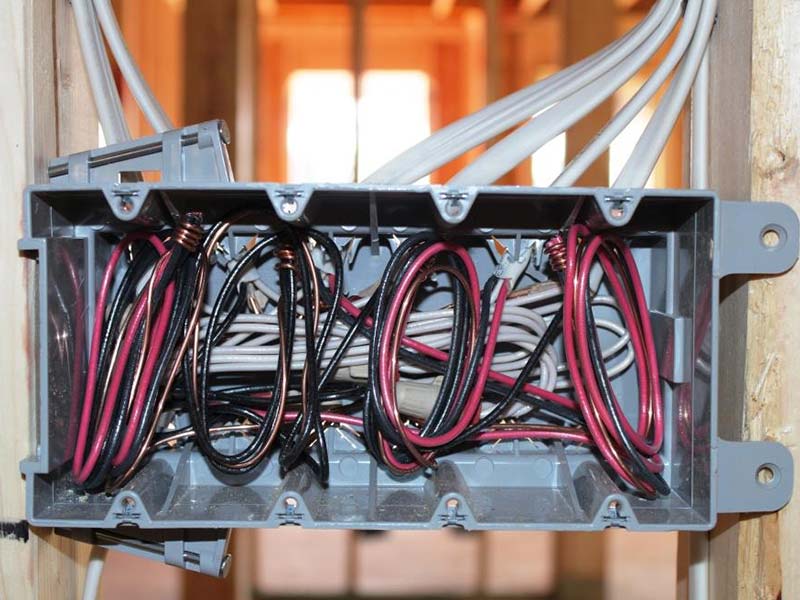Thankfully, you’re not Tom Cruise in the middle of a Mission Impossible movie, attempting to defuse a Nuclear bomb while frantically seeking to determine which color wire to cut.

L&M New Construction Wiring Job
But, while literally saving the world may not be your deal, you as a homeowner are likely wondering what the different color electrical wires throughout your house mean. This guide will help you understand these electrical colors and how to safely interact with wires when you do encounter them.
Before we jump into the color-coding meaning, we have an important message from our Atlanta office branch manager about wire coloring.
“The colors of the wires are only as good as the electricians that use them.” – David Smith, L&M Electric Branch Manager
David’s point is that while there is a meaning behind the coloring, colors are not always used correctly or uniformly (although they are reliable when purchasing mass-manufactured home products like ceiling fans). As you read our following electrical guide, keep this understanding in mind. And as we do in the field, test your wires to ensure the coloring matches what’s expected.

The Meaning Of Electrical Wire Colors
An easy way for electricians to identify the purpose of what’s happening beyond what the human eye can see is to use color-coded wiring. In residential, the colors we use for electrical conduction are BLACK, RED, and BLUE (blue is not as common in residential, but often found in ceiling fans). These energy conducting black, red, and blue “hot” wires are found throughout a wired home.
To return electricity to the electrical panel, residential electricians use WHITE wiring, also know as the neutral strand. Whether its a light bulb or some other electrically powered device, all electricity goes back to the panel through this wire. Back to the panel, the white connects to the neutral bar where the black wire will connect to the breaker.
Ceiling Mount Wired For New Home
 And the final color commonly found in homes is the GREEN ground wire, also known as the safety wire, keeps electricity in check (should it get out of control). When it comes to grounding, this function of a house’s electrical system is the top priority of the national electric codebook. When all wiring is appropriately grounded breakers will trip when designed to do so and you and your family will remain safe in otherwise dangerous situations.
And the final color commonly found in homes is the GREEN ground wire, also known as the safety wire, keeps electricity in check (should it get out of control). When it comes to grounding, this function of a house’s electrical system is the top priority of the national electric codebook. When all wiring is appropriately grounded breakers will trip when designed to do so and you and your family will remain safe in otherwise dangerous situations.
Outside of this coloring, the only other type of wiring you’ll sometimes come across is bare copper wiring with no color coating at all. This type of bare copper wiring is found in all electrical boxes. If aluminum wire is being used in the house, the bare aluminum wire that does not have a plastic coating would be used as the ground wire. This is usually found in some 220-volt applications and the service wire that runs between the outside meter and the main panel. Good ground wires don’t hold electricity (they dump it into the earth), as they are designed.

Fixing Incorrect Wire Coloring With Phasing Tape
Like we mentioned at the beginning of the article, the color is only as useful as it is used accurately. Mistakes happen, even with the best electricians, but often they’re the result of someone not paying attention or getting distracted on the job (which thankfully is more common in receptacles than it is in electrical panels). Color matching accuracy is also a good reason why we steer those with color blindness to choose another profession.
With a variety of testing tools, we can make sure the color corresponds to how the wire is actually being used for electricity. And, when a mistake is found, electrical phasing tape can be used to update the wire coloring in situations where replacing the wire is not practical or possible. You’re familiar with the most common electrical tape color, black. But electrical phasing tape is also found in the other colors of the rainbow. When needed, we update those color wires when servicing our electrical repair customers.
Wrapping Up The Electrical Wiring Color Conversation
When dealing with residential homes, black, red, and blue are the “hot” wires, white is neutral, returning power to the panel, and green is the ground wire moving electricity into the earth when no other safe place for it exists.
The coloring does not always represent the actual electrical movement, so be sure to test them before doing your electrical repair or installation. Better yet, L&M Electricians are available throughout the southeast United States (around metro Atlanta, Nashville, Huntsville, Birmingham, Greenville, and Columbia), so give us a call at 1-877-563-5328 for a free troubleshooting consultation.








